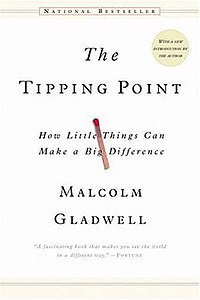The Tipping Point is the first book by journalist and author Malcolm Gladwell and is considered by many to be one of the most influential books in recent memory. It sets out to explain why epidemics of social change tend to spread. The main thesis here is that these “viruses” are spread because small groups of people know how to make big social connections and people can use micro pieces of good judgment to reach a macro audience. It was an entertaining read that helped explain things that on the surface seem obvious make more sense when analyzed. And yes, the copy I got from the library was filled with annoying highlights just like my last book review. (Seriously, who writes in a library book?)
According to Gladwell, a tipping point is “the moment of critical mass, the threshold, the boiling point.” In reference to our world it is the moment when a fad becomes a phenomenon. Gladwell says there are three types of people who make this happen: connectors, mavens, and salesmen. Connectors are the ones who know almost everybody and can make introductions, mavens are the talented ones and are great at disseminating new information, and salesmen are just so damn convincing you have no choice but to believe them. It should be noted that these groups make up 20 percent of the population as per the 80/20 rule where 20 percent of individuals tend to do 80 percent of the work. This part of the book resonated for me because we all know examples of who would fall under these categories. If I had to choose one for myself it would probably be salesman. I’ve always enjoyed debating when something was weighing on my mind and it made me realize how much influence these skills can have on our society.
This book is littered with case studies to illustrate the main point. In the introduction Gladwell examines Hush Puppies shoes and its parabolic sales in the mid-’90s. Word of mouth spread and to make a long story short the brand became popular again. When discussing the stickiness factor, which demonstrates the element of a certain content that makes it so addictive, he focuses on young kids’ programming like Sesame Street and Blue’s Clues. These shows, Gladwell says, are revolutionary by using a combination of narrative structure and repetition to help young children actually retain information. The final rule of epidemics in this book is “the power of context.” I think this factor is a bit of a cop-out because anything can be tied to context. But still, what Gladwell talks about here makes sense. Our environment can strongly influence our behavior.
There are several other examples in this book that I don’t need to get in to. A common criticism I’ve seen is that Gladwell relies on anecdotal evidence too heavily instead of going into scientific detail. But I’m okay because this book is not designed to enlighten the scientific mind; it’s designed to reach the average human being. It serves as a reminder to anyone who gets discouraged thinking only those with unlimited resources can make a difference. I think this can be applied to blogging or any other self-serving business. Everyone starts small but by doing a bunch of little things right and making the right connections, you can get the word out.
